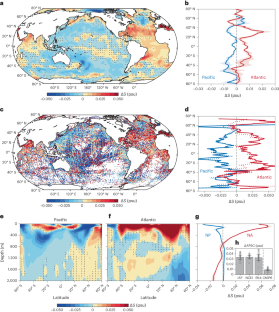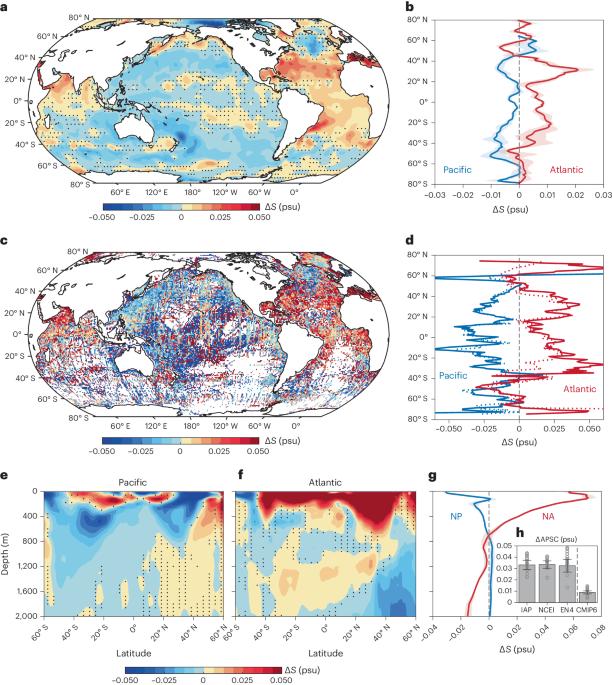North Atlantic–Pacific salinity contrast enhanced by wind and ocean warming
IF 27.1
1区 地球科学
Q1 ENVIRONMENTAL SCIENCES
引用次数: 0
Abstract
High salinities in the Atlantic and low salinities in the Pacific are critical ocean features, impacting ocean circulations and climate. Here, using observational data, we reveal that the Atlantic–Pacific salinity contrast has amplified during the past half-century. Notably, in the 0–800 m, 20°–40° N band, the Atlantic–Pacific salinity contrast increased by 5.9% ± 0.6% since 1965. A decomposition of heaving and spicing modes suggests vital contributions of wind and ocean warming, in addition to known surface freshwater fluxes. Specifically, ocean surface warming leads to poleward migration of thermocline outcrop zones, while surface wind changes cause upper-layer convergence in mid-latitudes. These processes lead to substantial upper-layer salinity increases in the North Atlantic but have much weaker signatures in the North Pacific, determined by the inter-basin difference in climatological salinities. This work highlights the complexity of ocean salinity response to climate change, underscoring the unexpected importance of wind- and heat-driven processes in the Atlantic–Pacific salinity contrast. Ocean salinity changes are thought to be dominated by freshwater fluxes. Here the authors show that amplification of the Atlantic–Pacific salinity contrast also involves wind- and ocean warming-driven processes, with larger salinity increases in the North Atlantic, relative to the North Pacific.


北大西洋-太平洋盐度对比因风和海洋变暖而增强
大西洋的高盐度和太平洋的低盐度是影响海洋环流和气候的重要海洋特征。在这里,我们利用观测数据揭示了大西洋-太平洋盐度对比在过去半个世纪中有所扩大。值得注意的是,在 0-800 米、20°-40° N 波段,大西洋-太平洋盐度对比自 1965 年以来增加了 5.9% ± 0.6%。对翻腾和加温模式的分解表明,除了已知的地表淡水通量外,风和海洋变暖也有重要作用。具体来说,海洋表层变暖导致温跃层出露区向极地迁移,而表层风的变化导致中纬度地区上层辐合。这些过程导致了北大西洋上层盐度的大幅上升,但在北太平洋的表现要弱得多,这是由气候盐度的海盆间差异决定的。这项工作突出了海洋盐度对气候变化反应的复杂性,强调了风和热驱动过程在大西洋-太平洋盐度对比中意想不到的重要性。
本文章由计算机程序翻译,如有差异,请以英文原文为准。
求助全文
约1分钟内获得全文
求助全文
来源期刊

Nature Climate Change
ENVIRONMENTAL SCIENCES-METEOROLOGY & ATMOSPHERIC SCIENCES
CiteScore
40.30
自引率
1.60%
发文量
267
审稿时长
4-8 weeks
期刊介绍:
Nature Climate Change is dedicated to addressing the scientific challenge of understanding Earth's changing climate and its societal implications. As a monthly journal, it publishes significant and cutting-edge research on the nature, causes, and impacts of global climate change, as well as its implications for the economy, policy, and the world at large.
The journal publishes original research spanning the natural and social sciences, synthesizing interdisciplinary research to provide a comprehensive understanding of climate change. It upholds the high standards set by all Nature-branded journals, ensuring top-tier original research through a fair and rigorous review process, broad readership access, high standards of copy editing and production, rapid publication, and independence from academic societies and other vested interests.
Nature Climate Change serves as a platform for discussion among experts, publishing opinion, analysis, and review articles. It also features Research Highlights to highlight important developments in the field and original reporting from renowned science journalists in the form of feature articles.
Topics covered in the journal include adaptation, atmospheric science, ecology, economics, energy, impacts and vulnerability, mitigation, oceanography, policy, sociology, and sustainability, among others.
 求助内容:
求助内容: 应助结果提醒方式:
应助结果提醒方式:


